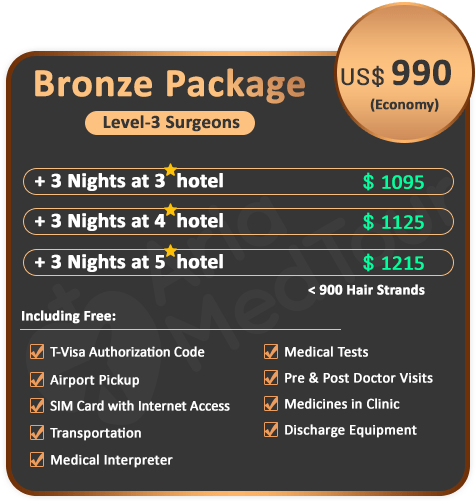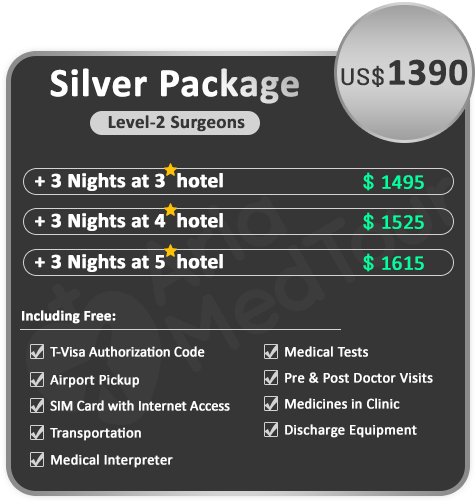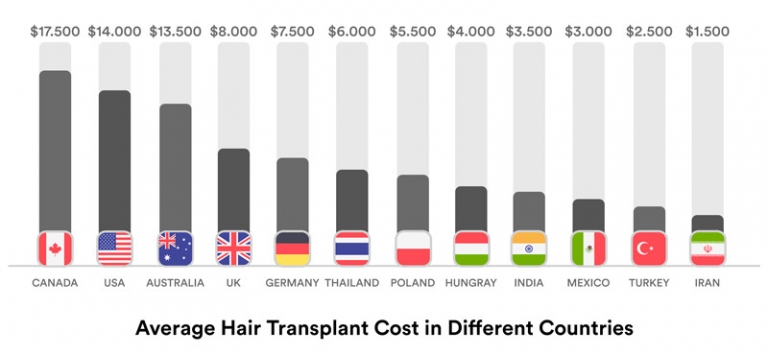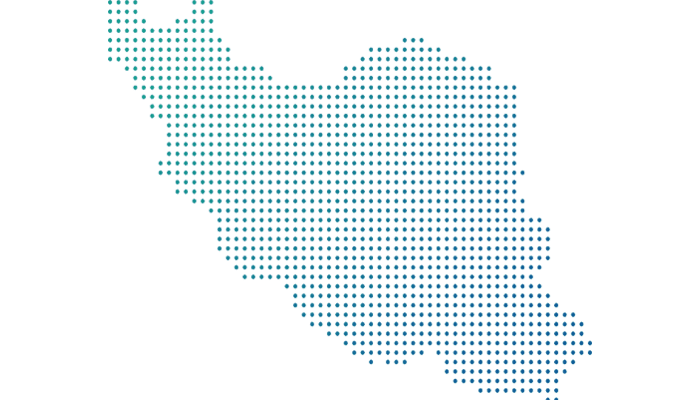HAIR TRANSPLANT IN IRAN
A hair transplant, which moves hair from one place to another on your head, can be done in several ways. The most common way is grafting. To be a good candidate, you’ll need to have thicker areas of hair on your head. Permanent hair loss can happen due to several reasons, including types of alopecia.
What is a hair transplant?
A hair transplant is a surgery that moves hair to bald or thinning areas of the scalp. Also called hair restoration or hair replacement, it’s usually for people who have already tried other hair loss treatments. Dermatologists (healthcare providers specializing in the skin) or plastic surgeons (healthcare providers specializing in reconstructive procedures) perform hair transplants.
How does a hair transplant work?
The healthcare provider takes grafts, or small pieces of skin, from areas of the body that contain healthy hair. Healthcare providers call this area the donor site. It’s usually on your head, at the back of your scalp where hair tends to be thickest. The healthcare provider moves the grafts to hairless parts of the scalp. Once the transplanted skin heals, it should continue to grow hair.
What are the different types of hair transplant surgery?
There are several different ways to perform hair transplant surgery, including:
Grafting.
Scalp reduction.
Flap surgery.
Tissue expansion
How is grafting performed?
Hair grafting is the most common type of hair transplant surgery. A healthcare provider cuts tiny pieces of the scalp containing healthy hair. Sometimes they use a small, round punch to remove skin that contains about 10 to 15 hairs. People used to call these grafts “hair plugs.” Micro-grafts contain one to two hairs.
The procedure can take several hours. Most people stay awake during the surgery, but they receive medication to numb the scalp. You may need several procedures depending on how much hair your provider needs to move. Your scalp will need to heal for a few months between procedures.
How is scalp reduction performed?
Providers also call scalp reduction alopecia reduction. During this procedure, a surgeon removes a small area of bald skin from the scalp. They loosen nearby skin containing hair and pull it over the bald area. Then, they stitch it in place.
Scalp reduction is ideal for bald areas on the top and back of the head. These sections are usually surrounded by skin with hair. Sometimes providers use scalp reduction and hair implants together to achieve full coverage. Like grafting, scalp reduction usually only requires numbing medication on the scalp. This means you don’t need general anesthesia.
How is flap surgery performed?
Your surgeon may recommend flap surgery if you have large bald areas near the front of your scalp. Flap surgery occurs in several phases over a few weeks. The surgeon makes superficial cuts around three sides of donor site. The fourth side remains attached, maintaining its original blood supply. This technique helps the surgeon cut the flap and lift it over bald areas. Flap surgery requires general anesthesia.
How long do the results of a hair transplant last?
It can take up to a year before you see the full results of any hair transplant. The transplanted hair may fall out as the graft or flap heals. This is normal. The hair should grow back. You may need several “touch-up” hair transplant surgeries to achieve a natural-looking result.
HAIR TRANSPLANT PACKAGES IN IRAN



WHAT DOES A SURGEON LEVEL MEAN?—————————————————————-
Our hair transplant packages have been classified into 3 levels mainly based on the surgeons’ competencies and also the hospital/clinic where the surgery takes place.
Our surgeons’ ranking is measured using different criteria, including:
- Skills and hands-on experience, evaluated based on the years of experience as a surgeon, the number of successful surgeries, the percentage of patient satisfaction.
- Academic background, evaluated based on the education level (considering their specialties and subspecialties), ranking in the board certification examination, the place of study (institution ranking), and the number of congresses, workshops, and courses attended.
The higher-ranked surgeons are the Iranian brand doctors who are also active on social media.
* Note that all our doctors are board-certified and have met AriaMedTour medical group’s standards.
———-WHAT WE OFFER——–
-
- Rhinoplasty
Clinic and doctor visits, medical tests, medical photography, nose surgery in hospital, post-operative care, medicines*, recovery, and follow-up
- Rhinoplasty
- T-Visa Authorization Code
T-visa authorization code. (Note that there is a separate visa fee that the patient must pay when receiving the visa, which it is not part of this package).
-
- Pick-up & Transfer
Airport pick-up, private transfer from hotel to clinic/hospital and vice versa
- Pick-up & Transfer
-
- Accommodations
7 nights stay in a three-star to five-star hotel offered which is preferably near the clinic or hospital
- Accommodations
- Other Services
24-hour on-call assistance, interpreter, SIM card and internet
Note: The medicines and other aftercare items included in this package are the necessary items prescribed by the surgeon.
Also, the doctors and hotels and clinics which are included in the package are offered by SinohemeMedTour to the patient. There may be other doctors whom the patients considered and the price might be different. Based on a new policy of the Ministry of Foreign Affairs, the citizens of the USA, UK, and Canada are included in different logistic services.
BEFORE & AFTER PHOTOS
Take a look at ‘before and after’ photos of people who got their hair transplant done in Iran.
Is Iran the right choice for my rhinoplasty?
Iran has all you need for a safe and effective rhinoplasty: highly-experienced surgeons, modern clinics and hospitals, and affordable costs. Iran is well-known for its rhinoplasty and is called the “nose job capital of the world.” Plus, Iran is a great country with a great culture and great people. A look at the testimonial videos of our rhinoplasty patients who had their nose job done in Iran will tell why Iran is a great country for your nose surgery.
HAIR TRANSPLANT IN IRAN: ALL YOU NEED TO KNOW
No one can deny the inseparable relation between hair, beauty, and self-confidence. Your hair may start to fall for a variety of reasons as you get older, impacting your beauty and, in turn, your self-confidence. So, if you’re looking for an affordable solution to your hair loss, here is a clear-cut path to getting your hair back again! And that’s hair transplant in Iran.
WHAT IS HAIR TRANSPLANT?
Hair transplant or hair restoration surgery is an effective treatment for alopecia (the problem of hair loss). It involves two parts:
- Removing hair-bearing tissues or hair grafts from one part of the scalp (donor zone)
- Relocating them to another part (recipient zone)
Donor zone refers to the area of the scalp, usually the back of the scalp, that has more hair with higher sustainability. Recipient zone refers to the balding part of the scalp that needs to grow hair. Hair loss or receding hairline mainly results from pattern baldness. Other factors like diet, stress, hormone, and disease contribute little to the hair loss.
WHY IS IRAN A GOOD DESTINATION FOR HAIR TRANSPLANT?
Hair transplant surgery is a common cosmetic procedure in Iran. With highly-experienced surgeons and modern hair transplant clinics, Iran offers foreign candidates a very safe experience of hair transplant.
The low cost of hair transplant in Iran serves as another motive, enticing candidates from all over the world to choose Iran as their destination. As is the case with lots of other cosmetic surgeries, the cost of hair transplant in Iran compared to other countries is considerably more reasonable.
Plus, the results of hair restoration surgery in Iran are reported to bring a very high level of safety and satisfaction for patients. A study on the success rate of hair transplant in Iran indicates that this surgery offers a high rate of success with the least possible side effects. The study reveals that the satisfaction level of the transplanted hairline in 60% of patients was excellent and in 40% was good. So, it would be fair if we claim that Iran is a highly successful country in providing quality hair transplant services.
HAIR TRANSPLANT SURGEONS IN IRAN
Just like other cosmetic/medical procedures, Iran’s becoming a household name in hair transplant. The country embraces a society of highly-skilled and board-certified surgeons in this field. Having graduated from top-rated universities, Iranian surgeons have completed their fellowships in hair transplant in Europe and the United States.
Studies show that in Iran three out of five men go bald before the age of 50. Accordingly, the number of candidates and those who undergo this surgery is on the rise. The more procedures surgeons perform, the better their surgery results are. As a result, this has brought more proficiency for Iranian surgeons in this field. These surgeons are, hence, able to anticipate all the complications that may arise before the surgery. And, this would guarantee the patient’s treatment success.
HAIR TRANSPLANT COST IN IRAN
The cost of a hair transplant in Iran is one of the lowest, if not the lowest, in the world among countries offering high-quality procedures as well as other medical tourism services. A hair transplant costs from $1200 to $2500 in Iran, including all the related fees such as doctor’s visit, anesthesia, surgery fee, and the rest. However, the same procedure in the United States and Europe costs much higher, from $4,000 to $16,000.
Iran beats other Asian countries like Turkey, India, and Thailand in terms of price, as it offers more affordable prices in hair restoration surgery. A hair replacement operation in Turkey costs around $3,000, and the same procedure costs around $3,000 in India and Thailand.
HOW IS HAIR TRANSPLANT PERFORMED IN IRAN?
Hair transplant in Iran is more advanced than ever, and surgeons do their best to help you get through it easily. Iranian hair transplant surgeons adopt the latest methods and technologies to help you get through it easily. The surgery is performed in a modern clinic under local anesthesia. The procedure takes about 8 hours, while the healing process takes at most 3-4 days. The first hints of your treatment would be visible after around 4 months, while the full results would be apparent after 8-12 months.
Moreover, Iran is a country offering all the techniques of hair loss treatment available in the world. There are four main techniques for performing this surgery. They include Follicular Isolation Technique (FIT), Follicular Unit Extraction (FUE), Follicular Unit Transplantation (FUT) also known as FUSS, and a combination of FIT and FUT. The latter is used in patients with extensive baldness, as in this method, more grafts are implanted on the scalp compared to other techniques. Read more about hair transplant techniques.
HAIR TRANSPLANT RECOVERY: WHAT TO EXPECT?
After your hair transplantation procedure is finished, you can go home right away. In general, you need to stay around 2 to 3 days in Iran to get your procedure done and be ready to leave the country.
In the first few days after the surgery, your scalp may be sore and tender. You can take pain medications according to your doctor’s instructions. You may also experience numbness and swelling in the treated area, which will disappear in a matter of days.
You will wear a bandage on the transplantation site for about 3 days. After that, you can have it removed while noticing that the side effects are going away.
After around 3 to 5 days, you’re ready to resume your work and you can go back to exercising within 2 weeks.
Tips to follow after hair transplant
At SinoheMedTour, we’ve been able to provide our hair transplant patients with the utmost care and effective treatment. Our services not only include pre-op attention, but also will help you have a short and hassle-free recovery. However, here we provide with some of the most important tips you should consider during your recovery:
- Rest for a day after your hair restoration procedure.
- For 3 nights, sleep with your head elevated and do not let it rub against your pillow.
- Do not take aspirin or any other medications without your doctor’s approval.
- For 2 weeks, do not expose your head to any dirt or bacteria.
- Wash your head after 3 days, but remember that you should be gentle with the treated areas.
- Stay away from alcohol and smoking before and after the surgery, as they may negatively affect your healing.
HAIR TRANSPLANT FOR WOMEN
Unlike what is expected by most people, women are, of course, candidates for hair transplant. According to the American Association of Dermatologists, hair loss for women is common. Women usually deal with two types of hair loss. One is receded hairline and the other is female pattern baldness. The former occurs in both men and women and can be treated with hairline lowering. In this case, the surgeon transplants hair from hair bank to the front of patients’ hair.
When hair loss pattern is not distinct and there’s a thinning/balding in all areas of the head, it may be due to female pattern baldness. A hair transplant may not always be appropriate for women, and other methods like Platelet Rich Plasma (PRP) and mesotherapy will do a far better job. PRP involves injecting rich platelets into the recipient area, after centrifuging the patient’s own blood for about 10 minutes. This stimulates hair follicles, thickens thin hair, increases hair volume, and promotes new hair growth. Mesotherapy is another method which triggers hair growth through injecting nutrients’ boosters into the scalp.
FACIAL HAIR TRANSPLANT IN IRAN (BEARD TRANSPLANT)
Today, there is a significant increase in the number of men who choose a beard or mustache transplant. They seek beard or mustache transplant to restore hair in areas of the face with no or thin hair. Facial hair transplant procedure is similar to a regular hair restoration surgery. Both FUT and FUE techniques can be applied in beard or mustache transplant. The procedure requires great preciseness because hair grafts need to be transplanted with the right growth direction so that the results look more natural and less artificial. To learn more about this procedure, go to beard transplant in Iran (facial hair transplant).
EYEBROW TRANSPLANT IN IRAN
Natural eyebrows are one of the most prominent elements of facial beauty. Many choose to have eyebrow transplant, or eyebrow hair restoration, to have natural-looking and permanent eyebrows. People seek eyebrow transplant for many reasons, including their eyebrows being over-plucked, burned, or affected by scarring or genetics.
Eyebrow transplantation is widely performed in Iran using both FIT and FUT methods. The donor hair can be harvested from any area on the body. But in most cases, it is taken from the head. The surgery is done under local anesthesia, and there is no scar left after the surgery. The recovery after eyebrow restoration surgery is fast, and the result is permanent.
Every year, a great number of people choose to undergo an eyebrow transplant in Iran. Affordability, top-rated clinics, and expert specialists are some of the main factors that come to play when considering why eyebrow transplant in Iran is gaining popularity.
Iranian specialists employ the latest medical techniques and adopt artistic approaches when performing the delicate procedure of eyebrow transplant. To maintain their competition, Iranian eyebrow transplant clinics are also fully equipped with the most recent technologies used in developed countries.
Eyebrow transplant cost in Iran
Eyebrow transplant cost in Iran starts from $800, which is by far lower than other countries in the region like Turkey or India. The affordable cost, however, does not affect the quality of the treatment. With thousands of eyebrow transplant procedures performed in Iran each year, Iranian specialists are highly experienced in this area. They take your expectations into consideration and use their experience as a tool to shape your eyebrows like an artist.
In order to achieve the best outcome for your eyebrow transplant, you only need to direct all your attention to the procedure itself. By knowing that your trip is thoroughly planned by our team, you will have greater peace of mind about your medical tourism journey. Contact us to get a free consultation and learn more about our hair transplantation services.
FREQUENTLY ASKED QUESTIONS ABOUT RHINOPLASTY
As the surgery is performed under general anesthesia, you won’t feel any pain during the operation. The degree of pain after regaining consciousness is different from person to person, depending on the patient’s pain threshold and the technique used (open and closed). Medications can help relive the post-operative nose job pain.
No one can claim that surgery is completely risk-free. However, the chance of developing complications after rhinoplasty can be greatly reduced by choosing the right surgeon.
Our board-certified rhinoplasty surgeons have at least 12 years of experience, having done over 5000 operations each during this period. This translates to their vast expertise in every aspect of nose surgery, giving you assurances that you will have a nose job as safe as possible with the most satisfactory result.
Is rhinoplasty permanent?
What is non-surgical nose job?
How long does a nose job last?
Will nose job leave scars?
Yes, the end result of a rhinoplasty lasts for good. Almost one year after surgery, when all swelling subsides and the nose gets the final shape, your nose is not expected to change form.
What is non-surgical nose job?
How long does a nose job last?
Will nose job leave scars?
It is a procedure in which fillers are injected into the nose in order to change its shape. The non-surgical rhinoplasty results do not last forever.
How long does a nose job last?
Will nose job leave scars?
Depending on the type of nose, and the technique used by the surgeon, it typically lasts between 1-3 hours.
Will nose job leave scars?
In closed rhinoplasty, as a small incision in made in the columella, there will be no visible scarring. In open rhinoplasty, the scarring left depends on the skill of the surgeon in making the incisions and sewing them up, and the skin thickness and texture (thin and light skin is less prone to scarring).
However, the scarring is often barely visible in most cases. Using anti-scar ointments and gels in the first 3 months after surgery can help reduce the scarring.
Check out the complete list of questions about Rhinoplasty


